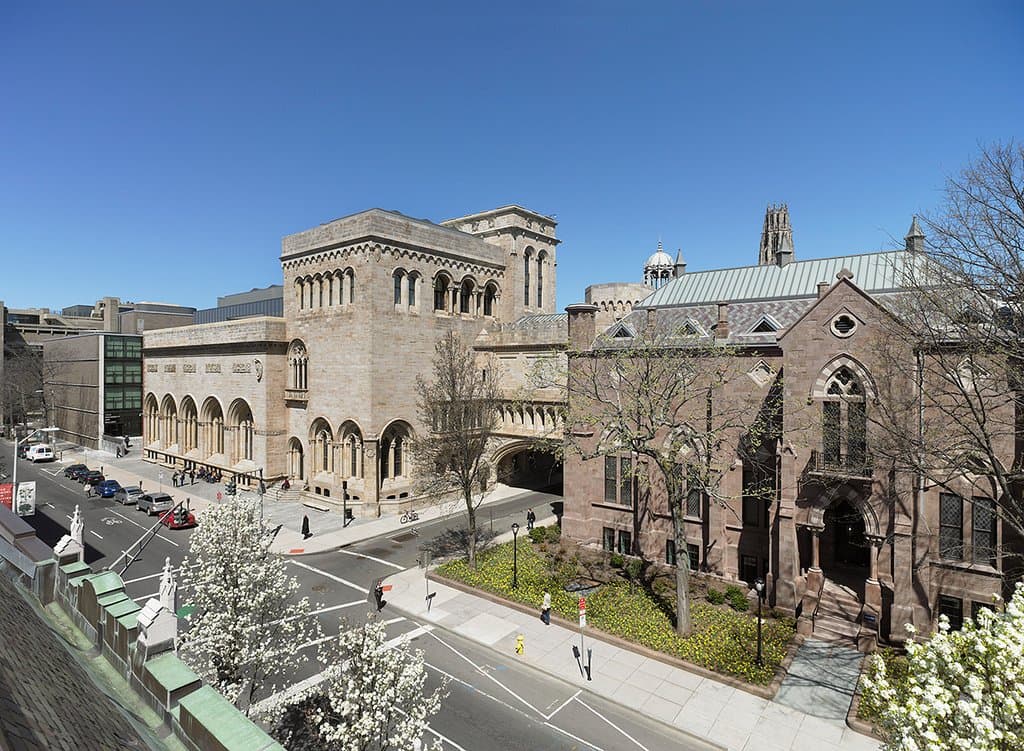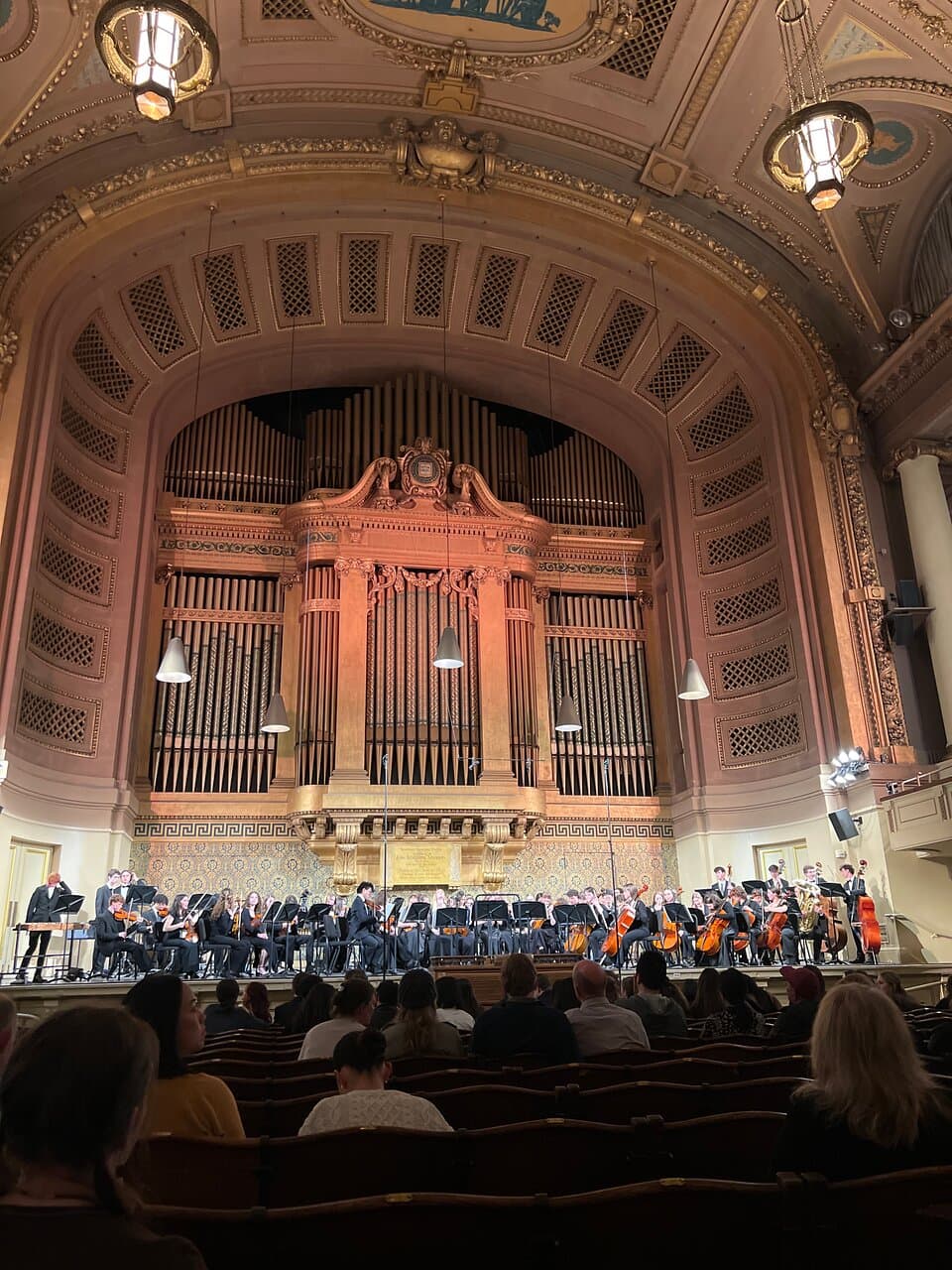Lipstick (Ascending) on Caterpillar Tracks
A colossal lipstick on tank treads, this Pop Art icon began as a protest and is now a celebrated Yale landmark.
Highlights
Must-see attractions

Social
From TikTok & Reddit
Best Time
Best light for photos
Lipstick (Ascending) on Caterpillar Tracks
Best Time
Best light for photos
Highlights
Must-see attractions
A colossal lipstick on tank treads, this Pop Art icon began as a protest and is now a celebrated Yale landmark.
"A paradox in aluminum and steel: revolutionary art transformed into a campus institution."

📸 Capture the Contrast
Photograph the striking juxtaposition of the lipstick and tank treads for a unique shot. :camerawithflash:
💡 Understand the History
Learn about its protest origins to fully appreciate its artistic and political significance. :books:

Highlights
Discover the most iconic attractions and experiences
The Lipstick Itself
Beinecke Plaza
A 24-foot-tall lipstick in vibrant crimson-orange, a striking symbol of Pop Art.
Tank Treads
Base of the sculpture
Massive steel treads that contrast sharply with the feminine form of the lipstick.
Juxtaposition of Forms
Entire sculpture
The unexpected fusion of beauty product and military hardware creates a powerful visual statement.
Plans like a pro.
Thinks like you
Planning Your Visit
A Monument to Dissent
From Provocation to Patrimony
Best Times
Insider Tips
from TikTok, Instagram & Reddit
📸 Capture the Contrast
Photograph the striking juxtaposition of the lipstick and tank treads for a unique shot. :camerawithflash:
💡 Understand the History
Learn about its protest origins to fully appreciate its artistic and political significance. :books:
🚶♂️ Explore Morse College
The sculpture is located at Morse College, known for its epic architecture. :college_uniform:
Tips
from all over the internet
📸 Capture the Contrast
Photograph the striking juxtaposition of the lipstick and tank treads for a unique shot. :camerawithflash:
💡 Understand the History
Learn about its protest origins to fully appreciate its artistic and political significance. :books:
🚶♂️ Explore Morse College
The sculpture is located at Morse College, known for its epic architecture. :college_uniform:
What Travellers Say
Reviews Summary
Visitors find the Lipstick (Ascending) on Caterpillar Tracks to be a visually striking and historically significant piece of Pop Art. Its unique juxtaposition of a lipstick and tank treads is consistently praised, though some note its transition from a protest symbol to a campus landmark. The sculpture's scale and artistic merit are widely appreciated.
"In a quiet corner of Yale's campus sits a paradox in aluminum and steel: Claes Oldenburg's mammoth lipstick mounted on tank treads, its revolutionary roar now reduced to a purr. Once deployed as artistic guerrilla warfare during the Vietnam era, this 24-foot sculpture has completed the journey from provocation to institution.
When student activists and Oldenburg secretly installed this cosmetic colossus on Beinecke Plaza in 1969, they weren't creating an Instagram backdrop. They were staging an aesthetic interventional complete with an inflatable vinyl tip that suggested both masculine aggression and feminine allure. The work was deliberate blasphemy against war and academic orthodoxy.
Today, Morse College's brutalist architecture frames the permanently installed sculpture, its vinyl replaced by durable materials, its confrontational stance repositioned to courtyard decoration. The university has expertly performed the alchemy of transforming protest into patrimony.
Yet the visual power persists. The crimson-orange lipstick remains startling against rust-colored treads and stone surroundings. The juxtaposition still resonates; beauty product meets military hardware, consumer culture fused with instruments of destruction. As Pop Art, it continues to demonstrate how everyday objects, magnified and recontextualized, reveal our cultural preoccupations.
Students lounge nearby, likely unaware they're studying beside Vietnam-era subversion. Future defense contractors and cosmetics executives alike pose with this protest symbol before entering industries it once critiqued. The military-industrial and beauty-industrial complexes find unexpected communion in this weathered emblem of dissent.
Would 1969 Oldenburg recognize his creation now? Revolutionary art often surrenders its bite for longevity; Sex Pistols as elevator music, Banksy prints in suburban homes, and Oldenburg's war machine/makeup applicator as campus landmark.
Nevertheless, essential tensions remain. The treads retain their menace; the lipstick still evokes both sexuality and superficiality. Its scale forces engagement with the ordinary made extraordinary. Even declawed, it addresses our contradictory relationship with militarism, consumerism, and gender.
This is revolutionary art's afterlife – celebrated yet defanged. Yale's lipstick-tank stands as both triumphant survivor and cautionary tale about institutions absorbing criticism through aesthetic rehabilitation. Perhaps some spark of its original disruption awaits rediscovery, ready to inspire the next generation of artistic insurgents."
Jeremy Edmunds
"Morse College is the most EPIC college therefore this statue is the best."
Gustavo T
"Its okay"
Finnian Agnew
What People Like
What People Dislike
Frequently Asked Questions
🚇 🗺️ Getting There
The sculpture is located at Yale University, specifically at Morse College. You can reach Yale's campus via public transportation or by car. Parking can be challenging, so consider using ride-sharing services or walking from nearby parking garages.
Yes, Yale University is well-served by public buses. Check local transit schedules for routes that stop near the campus.
While you can drive to Yale's campus, direct access to the sculpture's immediate vicinity might be restricted due to campus pedestrian zones. It's best to park and walk.
🎫 🎫 Tickets & Entry
No, the sculpture is an outdoor installation on Yale's campus and is freely accessible to the public.
As it's an outdoor public artwork, you can view it at any time. However, visiting during daylight hours is recommended for the best viewing experience.
Yale's campus is generally open to the public without an admission fee. Specific buildings or museums may have their own entry requirements.
📸 📸 Photography
The best light for photography is typically during the golden hours – shortly after sunrise or before sunset. Midday sun can create harsh shadows.
Generally, outdoor photography is permitted. However, always be mindful of students and faculty and avoid intrusive photography.
Experiment with low angles to emphasize the scale of the lipstick and treads, or try capturing it within the context of the surrounding architecture.
🎫 🏛️ Art & History
The sculpture was created by the renowned Pop Art artist Claes Oldenburg.
Originally installed as a protest piece in 1969 during the Vietnam War era, it symbolized dissent against war and academic orthodoxy.
It's a powerful juxtaposition of consumer culture (lipstick) and military hardware (tank treads), reflecting societal contradictions.
While its revolutionary bite has softened as it became an institutionalized landmark, the inherent tension between its elements still resonates.
For Different Travelers
Tailored advice for your travel style
👨👩👧 Families with Kids
While there are no specific child-focused amenities, the outdoor setting allows for freedom of movement. The sculpture is located within Yale's campus, which is generally safe and walkable. Consider making it part of a larger campus exploration, perhaps followed by a visit to a nearby park or a casual lunch. The key is to make it an engaging discovery rather than a dry art lesson.
🎓 Art & History Enthusiasts
Take time to observe the details: the scale, the materials, and the deliberate juxtaposition of the lipstick and tank treads. Consider how the sculpture's meaning has evolved from a radical statement to an institutionalized icon. Visiting Morse College also offers a chance to appreciate the surrounding brutalist architecture, which provides a unique backdrop for Oldenburg's work.
Deep Dives
In-depth insights and expert knowledge
The Art of Protest: Claes Oldenburg's Vision
The sculpture's placement on Beinecke Plaza was intended as a direct confrontation with the establishment and the war machine. It was a statement against academic orthodoxy and the military-industrial complex. Today, its permanent installation at Morse College frames it within the university's architecture, transforming it from a radical intervention into a celebrated campus landmark. This transition highlights how revolutionary art can be absorbed and reinterpreted by institutions over time.
Despite its institutionalization, the visual power of the lipstick ascending on caterpillar tracks persists. The striking contrast between the vibrant lipstick and the menacing treads continues to provoke thought about our contradictory relationships with militarism, consumerism, and gender. It serves as a reminder that even when declawed, art can retain its essential tensions and inspire reflection on the complexities of society.
From Guerrilla Art to Campus Icon
Over time, the sculpture has undergone transformations. The original inflatable tip was replaced with more permanent materials, and its location shifted to the courtyard of Morse College. This shift from a public plaza to a more contained academic space signifies its integration into the university's cultural landscape. While some might argue that this transition has softened its revolutionary edge, others see it as a testament to its enduring artistic merit and historical importance. The claes oldenburg lipstick ascending on caterpillar tracks is now a celebrated piece of public art, appreciated for its aesthetic qualities and its historical narrative.
Students and visitors now interact with the sculpture in a different context. It's no longer solely a symbol of protest but also an iconic landmark and a subject of academic study. The claes oldenburg lipstick on caterpillar tracks continues to spark conversations, albeit in a more nuanced way, about the intersection of art, politics, and consumer culture. Its presence on campus serves as a constant reminder of the power of art to challenge norms and reflect the complexities of its time.



Social
from TikTok, Instagram & Reddit